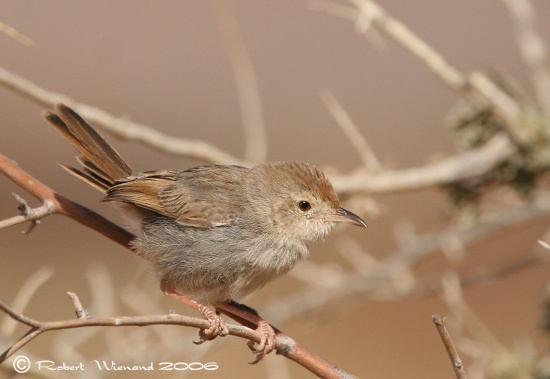Alternative name: Red-headed Cisticola
- Cisticola subruficapilla
Identification
13-14 cm
- Dullish dark rufous crown
- Reddish head
- Rufous panel in the folded wing
- Grey short straight bill
- Pinkish brown feet and legs
- Light brown eye.
The southern form, (southern Namibia and South Africa):
- Grey back streaked black
- White underparts
The northern subspecies:
- Brown back streaked black
- Buff underparts.
Sexes similar, but juveniles are duller with a yellow face
Distribution
Angola, Namibia and western South Africa. Associated with lowland fynbos, karoo scrub, and arid hillsides - typically in drier habitats than the closely related Wailing Cisticola.
Taxonomy
Cisticola subruficapilla has six subspecies:[1][2]
- C. s. newtoni
- C. s. windhoekensis
- Central Namibia
- C. s. karasensis
- North-central South Africa
- C. s. namaqua
- Southern Namibia and north-western South Africa
- C. s. subruficapilla
- Southern Western Cape Province
- C. s. jamesi
- South-central South Africa
Habitat
Shrublands in fynbos, renosterveld and Karoo; drainage lines with large tufts of Bamboo Grass; grassy patches on rocky hills in the Karoo; also shrubby and grassy areas on estuarine flats.
Behaviour
Diet
Forages low down in vegetation and on bare ground. Eats insects; termites, beetles, beetle larvae, caterpillars and small grasshoppers.
Breeding
Solitary nester building ball-shaped nests with side entrance out of dry grass and shreds of bark, hairy flower stalks, cobwebs and grass leaves. The clutch of 2 - 5 eggs being laid mainly between August and December.
Vocalisation
The call is a soft prrrrt followed by a sharp wheee phweee.
References
- Clements, J. F., T. S. Schulenberg, M. J. Iliff, D. Roberson, T. A. Fredericks, B. L. Sullivan, and C. L. Wood. 2014. The eBird/Clements checklist of birds of the world: Version 6.9., with updates to August 2014. Downloaded from http://www.birds.cornell.edu/clementschecklist/download/
- Hockey, PAR, WRJ Dean, and PG Ryan, eds. 2005. Roberts' Birds of Southern Africa. 7th ed. Cape Town: John Voelcker Bird Book Fund. ISBN 978-0620340533
- Wikipedia
Recommended Citation
- BirdForum Opus contributors. (2024) Grey-backed Cisticola. In: BirdForum, the forum for wild birds and birding. Retrieved 27 April 2024 from https://www.birdforum.net/opus/Grey-backed_Cisticola





